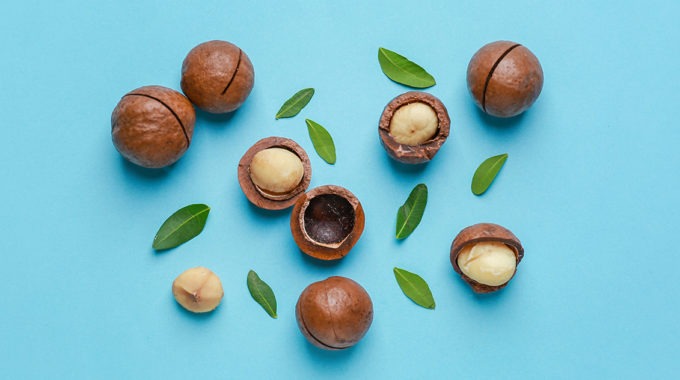Aussie macadamias, from seed to snack
Australian macadamias originated in ancient rainforests on the east coast more than 60 million years ago. Today’s macadamia industry remains centred here, where the rich volcanic soils and sub-tropical climate form the ideal environment for the nuts to flourish.
The high quality of our macadamias has led to a thriving industry – macadamias are now Australia’s fourth-largest horticultural export, behind almonds, table grapes and oranges. Australia exported around 70 percent of its macadamia crop for the last five years, and this figure climbed to 75 percent in 2020, despite the disruptions of COVID-19.
While the story of the Australian macadamia industry all began millions of years ago, its success today is due to its passionate and forward-thinking growers.
“The last few years in particular have seen an influx of new growers,” says Australian Macadamias Market Development Manager Jacqui Price. “It’s injected a youthful energy and an unprecedented appetite for innovation into our industry, with newer growers eager to adopt the latest on-farm technology and promote biodiversity in their orchards.”

Healthy farms for healthy trees
Grower Ross Arnett has been farming macadamias at Malua on the Alstonville Plateau in northern NSW for the past 10 years. The farm has been in his family since 1872, and has a 10-hectare orchard containing 2000 macadamia trees that range in age from seven to 17 years. Last year alone, Arnett’s farm produced 15 tonnes of macadamias, and is on track to produce 30-50 tonnes a year once all trees are in full production.
Arnett follows regenerative agricultural farming practices, and says he is constantly looking for kinder ways to nurture and grow his prized macadamia trees.
“Soil is the key to good farming,” he says. “I use compost to feed the soil biology and build healthy soil, which leads to healthy trees. Healthy trees have fewer pests and diseases. I’m also interested in exploring new ways to use less inputs on the farm and developing my own bio-fertilisers using waste fish products, seaweed and vermicast [worm poo].”
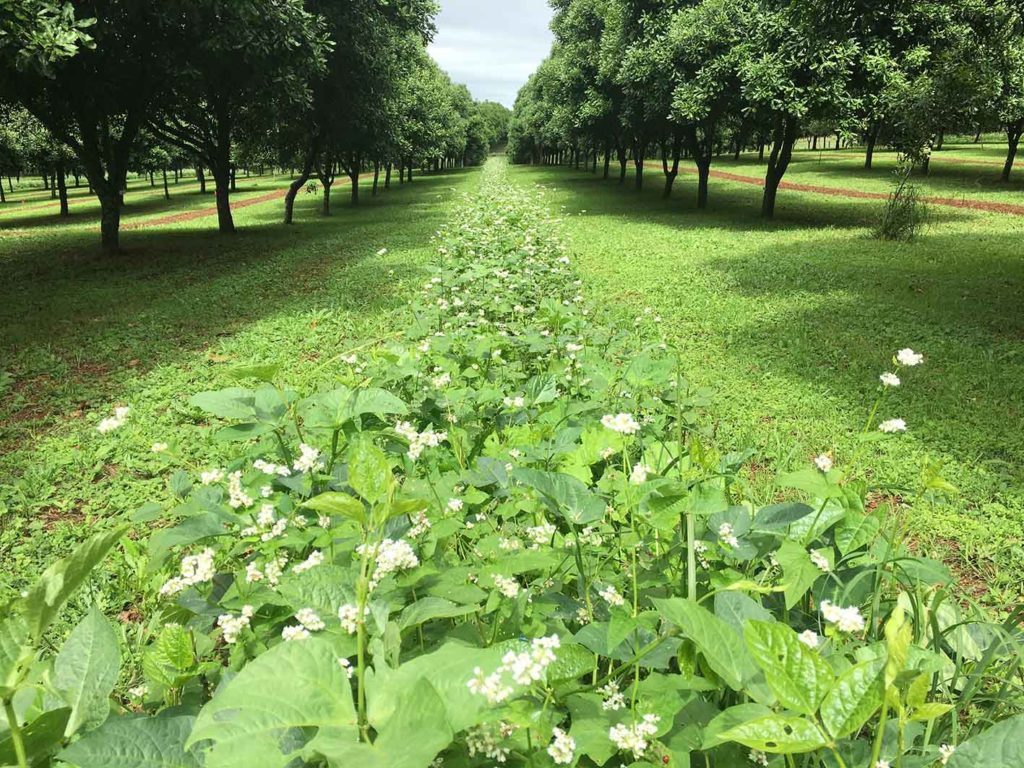
Working with nature
Biodiversity is also an important part of Arnett’s farming practices. He uses cover crops, shrubs, insects and birds to help create a healthy orchard environment.
“Around the perimeter of the orchard, I’ve planted tall-growing cover crops like sunflowers, sunn hemp and sorghum, mixed in with buckwheat and clovers,” he says. “That height diversity is really good for attracting insects and birds.”
In the rows between the trees, Arnett plants lower-growing cover crops. “The inter-rows bring beneficial insects into the orchard, including aphids,” he explains. “This then attract lady beetles and lacewings, which are predators of macadamia pests. It’s a complex natural arrangement that works beautifully.”
Even macadamia waste products are put to good use on Arnett’s farm. He uses macadamia husks and orchard tree prunings to make compost that feeds the soil.
“The husks have a high nutrient content, so they’re a great resource to put back into the orchard,” Arnett says. “We spend a lot of time working to improve soil quality. That’s where carbon sequestration takes place. And better soil makes better trees.”
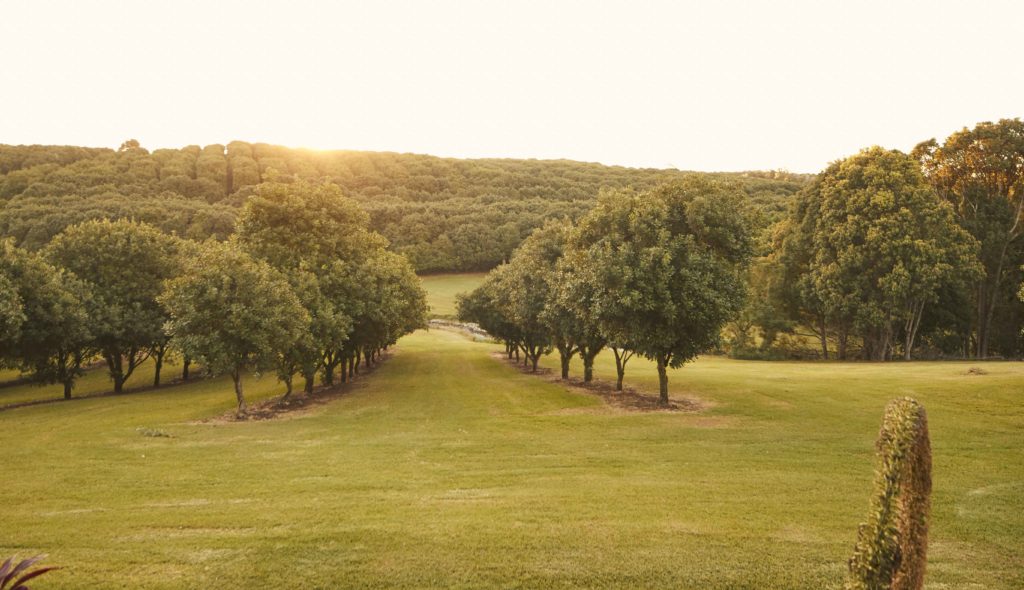
A hardy plant for a dry country
Macadamia trees can live for 100 years or more; an orchard near Arnett’s farm has been in production for more than 110 years. Trees start producing nuts after about seven years. However, it can take up to 15 years before a tree reaches full maturity and maximum yield.
While some crops can require a lot of water to maintain, macadamia trees are extremely water-efficient. The summer of 2019/2020 produced some of the harshest drought conditions growers have seen. Despite this, Arnett’s trees remained very healthy.
“They were still flushing [producing new leaves), even in those stressful conditions,” he says. “But climate change is a major challenge. We’re seeing increased severity of weather. Stronger winds can damage our trees, more frequent hail can cause crop loss, and of course, there’s drought. The 2019/2020 drought was the worst on record for our area.”
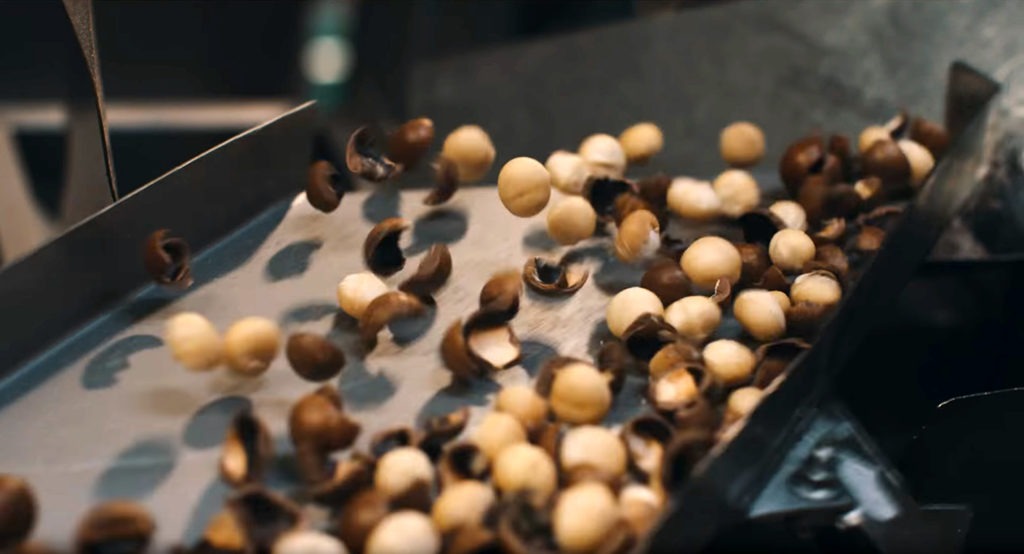
Pioneering process
Australia’s macadamia processors lie at the heart of the industry. As processors are located within the major growing regions along the east coast, the freshly harvested nuts don’t have far to travel to complete their transformation from nuts in shells to cracked and bulk-packed kernels, ready for dispatch to the supply chain.
In the past, tonnes of macadamia shells removed during processing were simply discarded. But recently, industry has realised the value of the hardy macadamia shell. Processors can use shells as an environmentally-friendly fuel to help dry the kernels. Activated charcoal made from macadamia shells can also be used to create carbon filters for water and air purification. And in 2017, scientists discovered that finely crushed macadamia shells were more effective than traditional charcoal treatments for poisons, such as drug overdoses.
Since macadamias are native to Australia, it’s no surprise that we pioneered macadamia processing. We became the first macadamia producer to implement rigorous quality standards and testing protocols. According to Price, by keeping safety and transparency as the cornerstones of their operations, our macadamia processors have been able to develop strong, long-standing relationships with commercial partners around the world.

The ultimate all-rounder
Once processed, manufacturers like Queensland-based Nutworks use macadamia kernels to produce a wide range of retail products. These delicious nuts are extremely versatile. There are many uses for macadamias, from chocolates and ice cream to snacks and macadamia oil. Nutworks uses macadamia kernels from Queensland and the NSW Northern Rivers to make its range of chocolate, confectionery and roasted snacks.
“Australian macadamias are the creamiest of macadamias,” says Nutworks CEO Kylie Watson. “They are well matched to both sweet and savoury flavour profiles.
“People also see Aussie produce as green and safe. I believe being an Australian brand is increasingly important, not only to Australian consumers, but to those in other markets.”

Room to grow
Despite its impressive reputation and strong export value, the Australian macadamia industry is still a relatively young one. This is especially the case when compared to other, more established horticultural industries such as citrus fruit, grapes and apples. But this just means that there’s plenty of room for improvement.
“Tree varieties are still quite primitive,” Arnett says. “So there’s lots of work taking place to develop smaller trees that reach maturity sooner and produce more nuts.”
Some growers have started using tree-shaking technology to improve their harvest efficiency. Arnett expects this will become more widespread in the future.
“There’s also room for further automation of sorting harvested macadamias before they reach the processor,” he says. “For instance, scanners could be used to identify and remove sub-standard nuts. It would be more accurate than doing it visually. Our quality standards are already very high, but we’re always looking for ways to improve.”
Australian researchers have also recently found a way to breed macadamias with thinner shells, bigger kernels and tougher husks that resist pests. This will ultimately result in bigger yields and better returns for our macadamia growers.
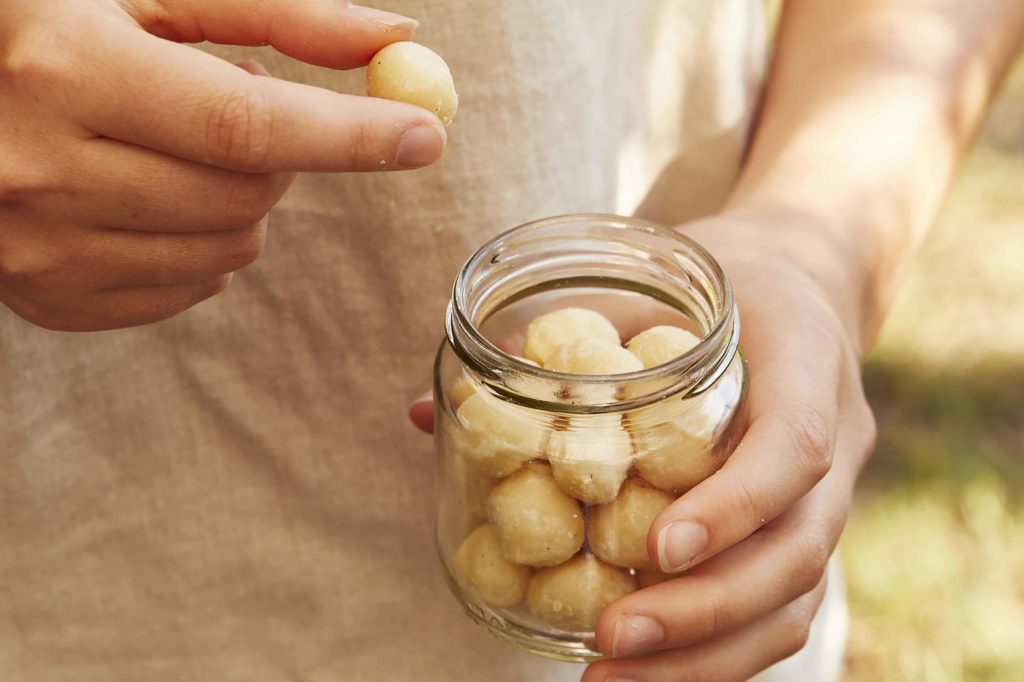
A healthier way to indulge
Macadamias aren’t just a creamy, buttery delight to eat; they’re also good for you, as they’re rich in healthy fats, antioxidants, vitamins, minerals, protein and fibre. This makes them good for your heart, brain, gut and skin. They can also help to lower the glycaemic index of carbohydrate-containing foods. This has a positive effect on blood sugar levels.
So, since they’re obviously a healthy choice (in moderation… especially when they’re coated in chocolate), more Australians really should be enjoying our native nut more often.
“I think everyone should eat more macadamias – they’re so good for you!” Arnett says. “Macadamia oil is great for cooking as it has a high smoke point, and it’s excellent in salads.
“My favourite way to use macadamias is to take small macadamia pieces, roast them in the oven and then use them to sprinkle on salads, stir-fries or desserts. Oh, and nothing beats homemade macadamia butter on sourdough!”
To find out more about Aussie macadamias, head to the Australian Macadamias website. To check out Nutworks’ full range, head to nutworks.com.au


